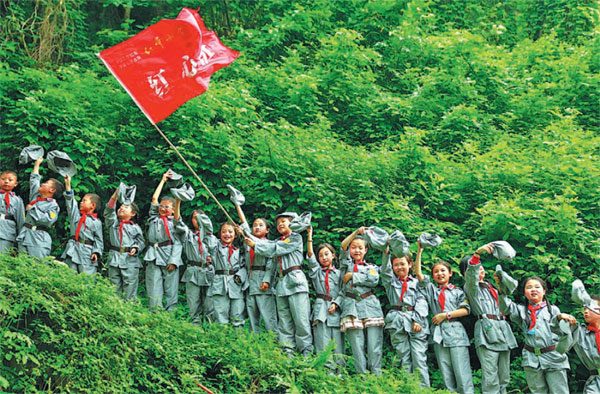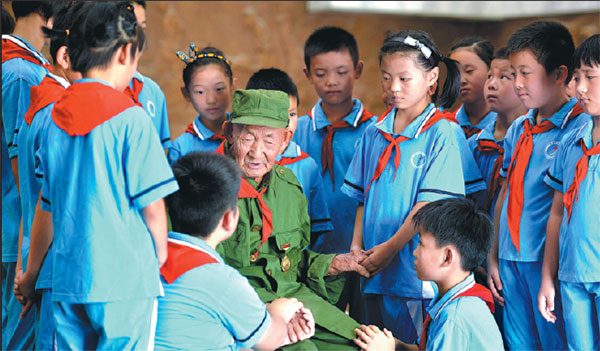
New measures are helping maintain love of country in the modern world
The past few years have witnessed changes in the education system aimed at further raising awareness of patriotism among young Chinese.
The National Anthem Law, approved in September by the Standing Committee of the National People’s Congress, the country’s top legislature, states that the national anthem should be played and sung at primary and middle schools nationwide.
“Schools should regard the national anthem as an important part of patriotic education for students,” according to the law, which came into force on Oct 1. “They are obliged to teach students to sing the anthem, learn its history and the spirit it reflects and obey the etiquette of singing it.”
Earlier this year, the Ministry of Education urged education departments across the country to revise textbooks for primary and middle schools by extending the duration of the War of Resistance Against Japanese Aggression to 14 years (1931-45) from eight (1937-45).
The move was intended to not only uphold the spirit of the 70th anniversary of the end of World War II and China’s struggle against the Japanese, which fell in September 2015, but also to strengthen patriotic education for the younger generation by allowing them to understand the history in a profound, all-around way, the ministry said.
Lyu Liangqiong, director of the student affairs office at the Shengli Experimental School in Hangzhou, Zhejiang province, who is responsible for designing the related curriculum and organizing activities for the students, has noticed the changes and the growing emphasis on patriotic education.
“China has changed so much during recent years and is growing more influential in the world, so I think it’s necessary to conduct patriotic education among young people, which will deepen their love for the country on the basis of better knowing and understanding,” she said.
According to Lyu, patriotic education at her school started becoming regular and systematic in 2009, when construction of the campus was completed and the school decided to weave the content of such education into school activities.
“For example, we bring students to historical places during the annual spring outings. Before setting out, we give lectures about the background information; while there, we guide students to listen to stories told by the descendants of revolutionary martyrs at those places. After they return, we ask them to generate and deliver work – a short article, an exhibition board or other forms,” she said.
“In the past, the spring event was purely an outing and just about having fun.”

Efforts to boost patriotic education made by the authorities of the People’s Republic of China can be dated back at least 35 years, when the country’s constitution, passed in 1982, stated that Chinese citizens should “love the country and the people … and receive education about patriotism, collectivism, internationalism and communism”.
Apart from the constitution, other laws, such as those related to education, stipulate that the country must offer patriotic education to students at all levels. The Teachers’ Law states that they have an obligation to conduct patriotic education for students.
President Xi Jinping has also stressed the significance of patriotism on a number of occasions in recent years.
For example, in a speech delivered at a collective group study among the Political Bureau of the Central Committee of the Communist Party of China in December 2015, Xi said patriotism is the spiritual core of the Chinese nation and patriotic education should run through the nation’s entire education system.
“Efforts should be made to enrich the form and content of patriotic education and ensure good results,” he said, suggesting that the great achievements in China’s reform and development, memorial activities for historic events, patriotic education bases, and traditional festivals and celebrations should be fully exploited to help people’s love for the country to grow.
New understanding
At Lyu’s school, patriotic education has been particularly stressed since January last year, when the Ministry of Education issued a series of guidelines in which it said patriotic education should be integrated with the design of the curriculum, textbook compilation and the examination and evaluation of subjects taught at schools.
“That inspired my colleagues and me to consider how we could make patriotic education part of our daily lessons, and make it easily understood and well-accepted by the students,” she said. “If we simply tell students to love the country, it may be too abstract and abstruse for them to understand.”
Some schools, such as Qianmen Primary School in Beijing, brought students to patriotic education centers such as the Red Star Education Center in Daxing district, where children can simulate walking the paths of the Red Army’s Long March and gain elementary impressions of what patriotism might be about. However, Lyu and her colleagues finally decided to start with a more practical approach.
They guide students to do things they are capable of: To love their families, teachers and classmates; to love the school by maintaining a clean and tidy campus; to love the city by appreciating its beautiful scenery; and to love traditional culture by – for instance – learning about the origins of each traditional festival.
“We believe that patriotism is not complicated. It can be perceived or interpreted through one minimal thing or another so even primary school students can make some contribution,” Lyu said. “In this way, we are transforming patriotism from slogans into action, turning patriotic education from cramming into a kind of experiential learning.”
Zhao Zhiwei, an associate professor of Chinese language and culture at East China Normal University, praised Lyu’s interpretation of patriotism.
“It’s sensible to let students know that patriotism is not far beyond their reach,” he said, adding that patriotism is not necessarily about sacrificing one’s life to guard the country, a sentiment frequently heard during wartime.
He said that in today’s China, doing the right thing and behaving oneself is also a way of showing love for the country, as this contributes to the national harmony and development.

New forms urged
In 1994, the Central Committee of the Communist Party of China issued a series of guidelines on how patriotic education should be conducted.
Following the guidelines, the following decade witnessed patriotic education carried out in various ways, such as organizing students to appreciate exhibitions, watch movies, visit historical places and take part in related speeches, knowledge and singing contests.
After being implemented for more than 20 years, the limitations of such forms of patriotic education have become increasingly obvious.
Xiong Bingqi, deputy director of the 21st Century Education Research Institute, said patriotic education delivered in these ways might help students to grasp some knowledge about the country, but in the meantime leave them bewildered about what patriotism really means and why they should engage.
“I would rather recommend students take part in social activities and get involved in voluntary services, which would cultivate their sense of social responsibility,” he said.
The education authorities had also recognized the necessity of updating the form and content of patriotic education to keep pace with the times.
A notice released by the Ministry of Education in February last year encouraged schools at all levels to innovate the ways by which patriotic education is conducted.
“By deploying the internet and new media, such as micro blogs and WeChat, schools should try to make patriotic education more vivid and appealing,” the notice said.
“A good atmosphere should be created on campuses to ensure that students will feel the spread of the patriotic spirit all the time, whether they are in or out of class, online or offline.”
However, Xiong said “a good atmosphere” should not be interpreted simply as hanging banners carrying patriotic slogans or having rituals such as raising the national flag while playing the national anthem.
“Foremost is creating a social environment that gives all students an equal opportunity to develop themselves, so that they will feel that they are well-treated and respected,” he said.
“People growing up in such an atmosphere will be grateful and spontaneously show their love for society and the country. And that’s how patriotic education should work.”
Decades of development
August 1994: An outline on the implementation of patriotic education was issued by the Central Committee of the Communist Party of China, stressing the significance of patriotic education and introducing measures on how it should be provided. The outline said patriotic education should be universal and mainly targeted at teenagers. Displays and exhibitions should include Chinese history, traditional culture, the achievements of the country’s socialist modernization, national conditions, socialist democracy and the legal system, among other things.
May 1995: Five ministries and committees, including the education and culture ministries, issued a circular recommending hundreds of books about patriotic education for teenagers to help raise their awareness of patriotism, strengthen their pride in the country and guide them to form a correct sense of value. The books included stories about Mao Zedong, an introduction to the four great inventions of ancient China, and the country’s reform and opening-up policy. The circular also encouraged teenagers to watch patriotic movies and sing songs that praise the country.
October 1996: Jiang Zemin, then-general secretary of the CPC Central Committee, told the sixth plenary session of the 14th CPC Central Committee: “Patriotic education must be strengthened among people across the country, especially among the younger generation… we should let our people know that carrying on reform and opening-up, learning from other nations to improve our own abilities and promote the development of our country are important aspects of patriotism.”
July 1997: The Central Committee of the CPC released, for the first time, a list of 100 patriotic education centers nationwide. Among them, 19 reflected China’s ancient history and culture, nine showed the country’s history of resisting foreign invaders, and 75 demonstrated the country’s revolutionary struggle and socialist construction.
The list covered a number of famous places, such as Tian’anmen Square and the Palace Museum in Beijing, the September 18 Historical Museum in Shenyang, Liaoning province, and the Sun Yatsen Mausoleum in Nanjing, Jiangsu province.
June 2001: A list of the second batch of national patriotic education centers was released to the public. The sites, including the memorial hall of the Battle of Beiping – Tianjin (July – Aug 1937) and the Li Dazhao Martyrs Cemetery, dedicated to one of the founders of the CPC, mainly focused the Party’s history. Another 140 centers were announced by the Central Committee of the CPC during the decade that followed.
March 2017: More than 40 sites were added into the list of national patriotic education centers, and the number of centers nationwide reached 428.


